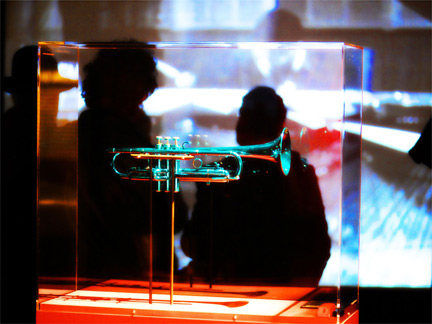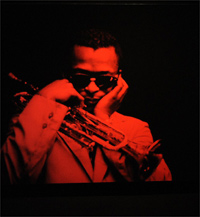We Want Miles
by Alison Hird
Article published on the 2009-11-23 Latest update 2009-11-24 10:25 TU
Culture in France: Miles Davis
How can you see music? When you first behold the Martin trumpet sitting next to the Selmer tenor saxophone, displayed like priceless relics in their own little room, you can’t help but be a bit moved. Especially if like me your tentative first steps towards appreciating jazz were via the iconic “Kind of Blue” on which Miles Davis and John Coltrane joined their creative forces and made what has become the most popular jazz record ever.
Along with the 7 trumpets on show, there are instruments Miles used in his orchestras such as a Fender electric keyboard and Fodra Monarch Deluxe bass guitar. Like all the objects in the exhibition (manuscripts, photos, concert recordings, stage costumes, artwork, TV interviews…), they illustrate how Miles Davis kept pace with his time and the latest technology.
While many jazz musicians spent a lifetime honing a particular sound, Miles Davis stands out as a musician obsessed with creating new ones.
It makes him an ideal subject for this first major jazz retrospective at the Cité de la Musique says curator Vincent Bessières.
“Every five years or so he would revolutionise his music. Starting in bee bop, then birth of cool, then in large orchestras with Gil Evans and modern jazz with “Kind of Blue” then the so-called Second Quintet with Herbie Hancock and Wayne Shorter and then going electric with “Bitches Brew”, and going into funk with “On the Corner...”
He was so diverse you can “divide his music into periods like you would for a painter” Bessières explains.
The exhibition traces his life from growing up in Saint Louis in Illinois through to his last concert in La Villette in Paris in 1991, just a few months before he died. But the focus is always on the music and visitors can listen to many of his key works in magnificent conditions.
Sound acousticians have designed small chambers in the form of the “mutes” Miles Davis famously used on the end of his trumpets. You’re literally enveloped in the sound, experiencing the music as if you were there with the musicians in the studio.
As you’re serenaded by Kind of Blue, savouring the legendary trumpet and saxophone, you can ponder notes made by producer Teo Massero during the recording sessions, or simply gaze at the many atmospheric black and white photos of the time.
Film footage of Miles in concert shows some of the radical musical turnabouts of his 50-year career. Like the legendary Isle of Wight concert in 1970, a huge pop festival unaccustomed to jazz musicians and which marked his move from acoustic to electric.
“He was the only so-called jazz musician to perform there because at that time his music was really influenced by Hendrix and all those new electric keyboards that changed the sound of music. He reached an entirely new audience that was basically white hippies” Bessières explains.
And while a lot of jazz fans were puzzled, even alienated by the move into electric “he never went back” adds the curator.
The title of the exhibition “We want Miles” refers to one of the live albums that marked his comeback in 1981, after 6 years of total reclusion. Never one for false modesty, Miles Davis anticipated his fans were desperate to see him back performing and returned as a self-proclaimed living legend. The second half of the exhibition is devoted to this part of his life: the garish stage costumes, numerous TV and magazine interviews, the heavily staged “prince of darkness” type photos for album covers. But none of this was at the expense of the music.
“He used his legend as a way of making a good living. But he didn’t rely on his stardom to make music. He kept evolving”, explains Bessières. “It was a time of synthesisers and home studio programming. He was very aware of what was going on.”
Miles collaborated, albeit briefly, with Prince, and had a huge worldwide hit “Tutu” composed and written by Marcus Miller. Warner Bros thought Miles Davis was sufficiently famous to have just his portrait on the album cover with no mention of his name. They were right.
His last album “Doo-Bop”, released posthumously in 1992, was far from his best but showed his ongoing desire to work with new young talent, in this case rappers.
The exhibition ends with footage of the final concert he gave in Paris at La Villette in 1991. In recognition of his debt to Paris he agreed to play some of his old tunes, something he’d resolutely always refused to do. Hard to imagine the Stones in concert without a reprise of Brown Sugar, U2 without Sunday Bloody Sunday, Prince without Purple Rain…
While Miles spent little time in France, Bessières says it counted a lot because the French considered him “an artiste as opposed to simply a musician”. He first came in 1949 thanks to writer and jazz lover Boris Vian. “Miles was only 23 and was amazed that foreigners knew him so well and treated him as a creative mind”.
Vian also introduced him to the singer Juliette Greco with whom he had a “short but meaningful” affair. Miles enjoyed the freedom of dating a white woman: unthinkable in the U.S. at the time due to the laws on racial segregation.
Nouvelle vague filmmaker Louis Malle also held his creativity in high esteem. In 1957 Malle invited him to compose the soundtrack to his film “Ascenseur pour un échafaud”. It was recorded in just one session, Miles improvising to the film while it was projected in the recording studio.
As the young, moody Jeanne Moreau walked down the Champs Elysees at night in the rain, Miles Davis’s melancholy trumpet sounded out the darker, solitary side of the city of lights. It also guaranteed the film’s success.
We want Miles runs at Cité de la Musique until 17 January.
There’s also a virtual visit of the exhibition subtitled in English available.
Culture
Cracking skulls!
2010-02-15 12:35 TU
France's gothic avant-garde
2010-02-13 15:16 TU
Winter sounds warm up French jazz fans
A tribute to trumpeter Don Cherry at a Free Jazz showcase festival outside of Paris.
2010-01-31 11:55 TU
Trance on a trapeze
2010-01-30 12:41 TU
Retro Mobile - classic car exhibition
260,500 euros for rusty old car found at bottom of lake
A rusty old Bugatti, which spent years at the bottom of a Swiss lake, sold for 260,500 euros at the Retro Mobile classic car exhibition on Saturday. Other more lovingly-restored pristine examples are exciting enthusiasts from across the world in a special anniversary event at Porte de Versailles in Paris.
2010-01-23 20:21 TU
France's changing face looks east
2010-01-22 16:17 TU
Putting art on film
2010-01-20 13:09 TU
What sex is a coffee bean, where does the aubergine come from?
2010-01-08 16:08 TU
Cocteau Twin flying solo
2010-01-06 16:43 TU
A taste of Nordic filmmaking in Paris
Ciné Nordica 2009 at Paris’s Panthéon cinema showcases filmmaking from Scandinavia. So what makes Nordic film different from the rest?
2009-12-22 17:15 TU
Blend of an era: South Africa’s jazz age
2009-11-20 17:36 TU



















